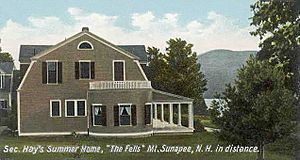The Fells facts for kids
Quick facts for kids |
|
|
The Fells
|
|

The Fells (John Hay Estate)
|
|
| Location | Newbury, New Hampshire |
|---|---|
| Area | 164 acres (66 ha) |
| Built | 1891 |
| Architect | George Hammond (1891) Prentice Sanger (1915) |
| Architectural style | Colonial Revival |
| NRHP reference No. | 00001288 |
| Added to NRHP | 2 November 2000 |
The Fells, also known as the Hay Estate, was once the summer home of John Milton Hay. He was an important American statesman in the 1800s. The Fells is located in Newbury, New Hampshire, near Lake Sunapee. It's a beautiful spot where history and nature meet.
Contents
The Fells: A Historic Summer Home
John Hay had a long career serving the United States for over 40 years. He was Abraham Lincoln's private secretary during the American Civil War. Later, he worked as a diplomat and a journalist. He became the United States Secretary of State in 1898, serving until he passed away in 1905.
In the late 1880s, farms in New Hampshire were struggling. The state encouraged wealthy people to buy these farms. This helped keep the farms going. In 1888, John Hay bought about 1,000 acres (400 ha) of land. It was along the shore of Lake Sunapee. He wanted a quiet place to escape the busy life in Washington. Hay named his property "The Fells." This is a British word for rocky, uphill pastures. He chose the name because of his Scottish family background.
Building the Hay Estate House
The first small house on the property was built in 1891. Architect George Hammond oversaw its construction. In 1897, a second guest house was added next to the first one. The main entrance of the first house faced the lake. This was because the Hay family often arrived by boat.
After John Hay passed away in 1905, his son, Clarence Hay, inherited the property. Clarence and his wife Alice wanted to make the rustic summer houses grander. Starting in 1915, they worked with architect Prentice Sanger. They changed the house into the Colonial Revival style. A covered walkway between the two houses became a formal hallway. This joined the two separate houses into one large home. Later, a garage was built for the family's cars.
In 1960, the Hay family gave 675 acres (273 ha) of land to the Society for the Protection of New Hampshire Forests. After Clarence Hay died in 1969, Alice Hay gave another 164 acres (66 ha) to the United States Fish and Wildlife Service. She kept some land for her family to use during their lives. Alice continued to visit The Fells every summer until she passed away in 1987. The remaining land then became the John Hay National Wildlife Refuge.
Work to fix up the house and land began in the 1990s. In 1996, a non-profit group called "The Fells" was created. This group now manages the house and its surrounding lands. In 2008, The Fells bought the land around the main house. They did this through a land swap with the Fish and Wildlife Service.
The Fells is listed on the National Register of Historic Places. It is important because it shows how summer estates were built in New Hampshire in the late 1800s. It is also famous for its connection to John Hay. He was a leading politician and diplomat. John Hay wrote the Open Door Policy at The Fells. This policy said that no country should try to take over China. Teddy Roosevelt visited The Fells in the summer of 1902. A maple tree, now called the Roosevelt Tree, was planted during his visit.
The Fells Today
Today, many volunteers help take care of The Fells. There is also a garden staff and administrators. The house and its beautiful gardens are open to the public. The Fells hosts many fun cultural and educational events for visitors.
John Hay National Wildlife Refuge
| John Hay National Wildlife Refuge | |
|---|---|
|
IUCN Category IV (Habitat/Species Management Area)
|
|
| Lua error in Module:Location_map at line 420: attempt to index field 'wikibase' (a nil value). | |
| Location | Merrimack County, New Hampshire, United States |
| Nearest city | Newbury, New Hampshire |
| Area | 80 acres (0.32 km2) |
| Established | 1987 |
| Governing body | U.S. Fish and Wildlife Service |
| Website | John Hay National Wildlife Refuge |
The John Hay National Wildlife Refuge was created in 1987. Its main goal is to protect migratory birds. In 2008, the refuge was divided. The northern part, which included the buildings, was given to The Fells organization. In return, other lands in northern New Hampshire were added to the Umbagog National Wildlife Refuge.
The remaining part of the refuge is about 80 acres (32 ha). It has different kinds of trees, a small meadow, and wetlands. It also protects about 3,100 feet (940 m) of undeveloped shoreline along Lake Sunapee. The refuge focuses on protecting nature, especially for migratory birds and their homes.
The refuge is open to everyone during daylight hours, all year round. You can watch wildlife, take pictures, and learn about nature. There is a 0.9-mile (1.4 km) trail called the John Hay II Forest Ecology Trail. It's a self-guided walk through the forest and along Lake Sunapee. You can park your car at The Fells to access the trail.
See also


